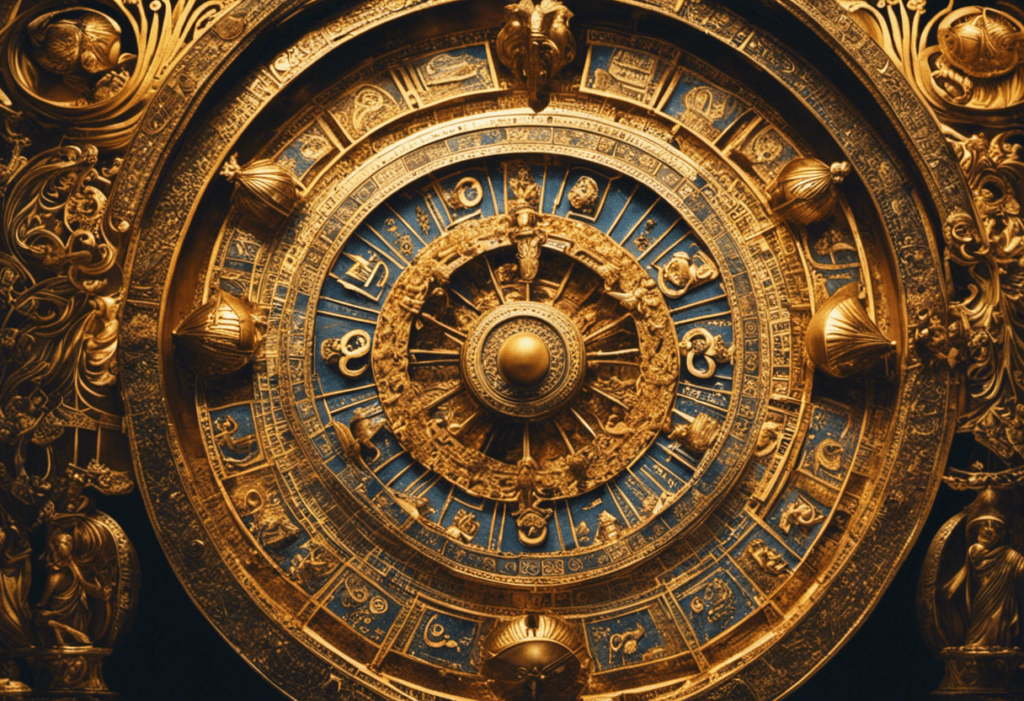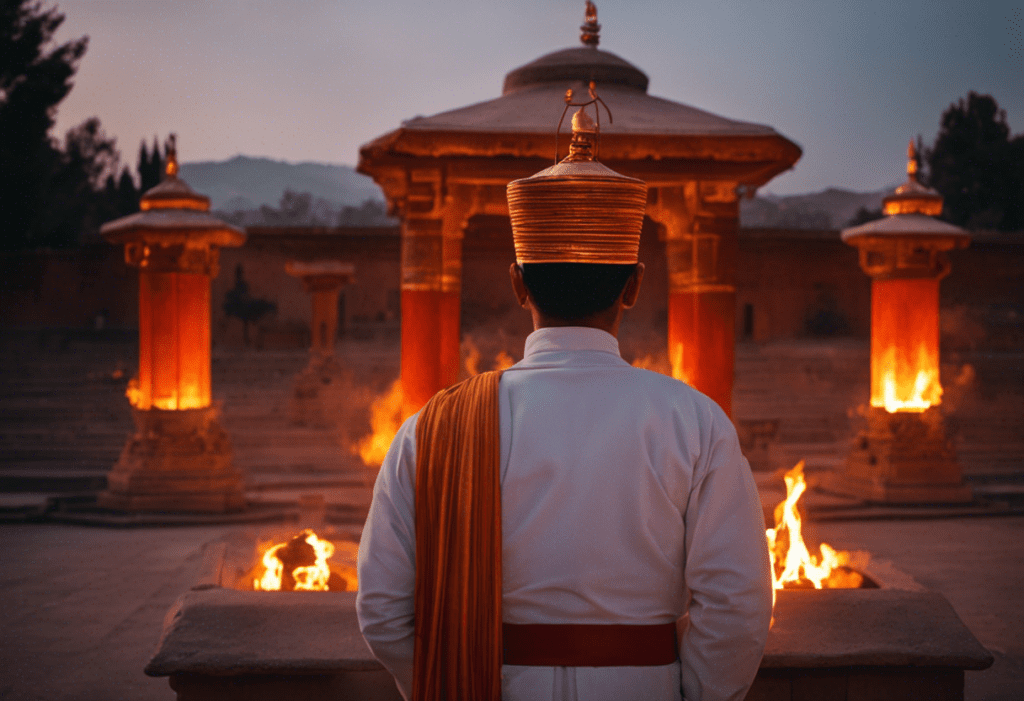In the realm of art and iconography, the Zoroastrian calendar holds a significant place. Its origins date back to ancient times, and its symbolism and imagery have inspired countless artists throughout history.
This article delves into the rich tapestry of Zoroastrian calendar art, exploring how it has been depicted in paintings, drawings, sculptures, and statues. By examining the cultural significance of this iconography, we unravel the deep-rooted connections between art and spirituality in Zoroastrianism.
Key Takeaways
- The Zoroastrian calendar was developed in ancient Persia by the prophet Zoroaster in the 6th century BCE.
- The calendar is based on the solar year with twelve months, and additional days are added at the end of the year to account for remaining days.
- Zoroastrian calendar art incorporates symbolism and imagery, representing cosmic elements, animals, and mythological figures.
- The calendar is depicted in paintings, drawings, sculptures, and statues, reflecting the cultural and religious significance of ancient Persia and the beliefs of Zoroastrianism.
The Origins of the Zoroastrian Calendar
The origins of the Zoroastrian calendar can be traced back to ancient Persia, where it was developed as a means to organize religious festivals and agricultural activities. Zoroastrianism, one of the oldest known religions, was founded by the prophet Zoroaster in the 6th century BCE. The calendar played a crucial role in the religious and social life of the Zoroastrian community, regulating their daily activities and providing a framework for their religious observances.
The development of the Zoroastrian calendar can be seen as a response to the need for an organized system to mark the passage of time and to synchronize the rituals and agricultural practices of the community. The calendar was based on the solar year and consisted of twelve months, each with thirty days. To account for the remaining five or six days, additional days were added at the end of the year.
Over time, the Zoroastrian calendar underwent several modifications and adaptations. With the influence of neighboring cultures and the spread of Zoroastrianism to different regions, the calendar incorporated elements from other calendars, such as the Babylonian and the Persian. Despite these changes, the core principles and purpose of the calendar remained intact.
The Zoroastrian calendar’s origins and development reflect the importance of timekeeping and religious observance in the ancient Persian society. Its legacy continues to endure today, with Zoroastrians worldwide using variations of the original calendar to mark their religious festivals and commemorate important events.
Symbolism and Imagery in Zoroastrian Calendar Art
A deep exploration into the symbolism and imagery present within Zoroastrian calendar art reveals the intricate connections between religious beliefs and visual representations. The interpretation and meaning of Zoroastrian calendar symbols have evolved over time, reflecting the changing cultural and religious landscape of the ancient Persian civilization.
Here are four key points to understand the symbolism and evolution of Zoroastrian calendar art:
-
Cosmic Elements: The symbols in Zoroastrian calendar art often represent cosmic elements such as the sun, moon, stars, and planets. These celestial bodies are associated with the divine and are believed to have a significant impact on human lives.
-
Symbolic Animals: Animals, such as the lion and the bull, feature prominently in Zoroastrian calendar art. These animals represent strength, power, and fertility, symbolizing the divine forces of nature.
-
Mythological Figures: Zoroastrian calendar art frequently depicts mythological figures like Ahura Mazda, the supreme deity, and Angra Mainyu, the embodiment of evil. These figures represent the eternal conflict between good and evil and the struggle for cosmic balance.
-
Cultural Influences: Zoroastrian calendar art has evolved through different time periods, incorporating influences from various cultures. For example, during the Parthian period, Hellenistic artistic elements were incorporated into Zoroastrian calendar art, resulting in a unique fusion of styles.
Depicting the Zoroastrian Calendar in Paintings and Drawings
An artist’s interpretation of Zoroastrian calendar symbols through paintings and drawings provides a visual representation of the ancient Persian civilization’s religious beliefs. The Zoroastrian calendar, believed to have been created by the prophet Zarathustra, played a significant role in the religious and cultural practices of ancient Persia. The calendar consisted of twelve months, each named after a specific deity or celestial body, and was based on the solar year. The symbols associated with the calendar, such as the winged disk, the lion, and the sun, hold deep religious and historical significance.
Historical influences can be seen in the artwork depicting the Zoroastrian calendar symbols. These artworks often showcase the influence of Persian art and architecture, as well as the artistic styles prevalent during the time period. The use of vibrant colors, intricate patterns, and detailed motifs reflects the artistic sensibilities of the ancient Persian civilization.
In modern interpretations of the Zoroastrian calendar symbols, artists often explore the religious and cultural significance of these symbols in contemporary contexts. They may incorporate elements of symbolism, mythology, and spirituality to create visually captivating and thought-provoking artworks. These modern interpretations serve as a reminder of the enduring legacy of the Zoroastrian civilization and its impact on art and culture.
Sculptures and Statues Inspired by the Zoroastrian Calendar
Several sculptures and statues intricately depict the symbols and deities of the Zoroastrian calendar, showcasing the artistic talent and cultural significance of ancient Persia. These artworks provide a window into the beliefs and practices of the Zoroastrian religion, which was one of the major faiths in Persia before the rise of Islam. The Zoroastrian calendar, known as the Shahanshahi calendar, is a solar calendar that consists of twelve months and is based on the movements of the sun and the stars.
Contemporary interpretations of Zoroastrian calendar sculptures have gained popularity in recent years, as people are drawn to the rich symbolism and spiritual significance associated with these ancient Persian traditions. Artists and designers have incorporated elements of the Zoroastrian calendar into their work, creating unique and eye-catching jewelry and accessories. These pieces often feature intricate carvings or engravings of the Zoroastrian symbols, such as the Faravahar, a winged symbol representing the divine spirit and eternal life.
The popularity of Zoroastrian calendar inspired jewelry and accessories reflects a growing interest in ancient cultures and their spiritual practices. By wearing these pieces, individuals can connect with the wisdom and traditions of the past while also expressing their personal style and beliefs. This fusion of ancient and modern aesthetics serves as a reminder of the enduring power and beauty of the Zoroastrian calendar and its cultural heritage.
The Cultural Significance of Zoroastrian Calendar Iconography
The study of Zoroastrian calendar iconography illuminates the rich cultural heritage and religious symbolism embedded in the ancient Persian tradition. The Zoroastrian calendar, known as the Zoroastrian religious calendar, has a long historical evolution and is an integral part of Zoroastrian religious practice. The calendar is based on the solar year and consists of twelve months, each associated with a specific deity or divine attribute.
The iconography associated with the calendar reflects the beliefs and values of Zoroastrianism, and serves as a visual representation of the religious and cultural identity of the Zoroastrian community. Historically, Zoroastrian calendar iconography has been depicted in various forms of art, including paintings, sculptures, and manuscripts. These artworks often depict the twelve months and their associated deities, as well as the various festivals and rituals that are celebrated throughout the year.
The iconography also includes symbols and motifs that are significant in Zoroastrianism, such as the Faravahar, which represents the divine spirit and eternal life. In contemporary interpretations, Zoroastrian calendar iconography continues to be an important aspect of Zoroastrian religious and cultural practices. It is used in religious ceremonies, as well as in the decoration of sacred spaces and personal belongings. The iconography serves as a reminder of the rich history and spiritual significance of the Zoroastrian tradition, and helps to maintain a connection with the ancient Persian heritage.
Conclusion
In conclusion, the Zoroastrian calendar holds immense cultural significance, evident in its portrayal through various art forms. The intricate symbolism and imagery found in Zoroastrian calendar art reflect the deep spiritual beliefs and philosophies of the ancient religion.
Whether depicted in paintings, drawings, sculptures, or statues, the calendar serves as a visual representation of the religious and cultural practices of the Zoroastrian community. Through its iconography, the Zoroastrian calendar continues to captivate and intrigue audiences, providing a glimpse into an ancient civilization’s perception of time and existence.



